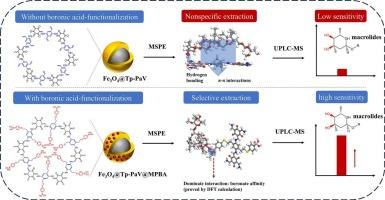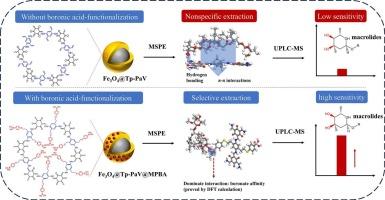硼酸功能化磁性共价有机骨架的合成及其在水和牛奶样品中大环内酯类抗生素的选择性提取和测定
IF 9.8
1区 农林科学
Q1 CHEMISTRY, APPLIED
引用次数: 0
摘要
制备了一种新型硼酸功能化磁性共价有机骨架(Fe3O4@Tp-PaV@MPBA)作为磁性固相萃取(MSPE)吸附剂,用于水和牛奶样品中7种大环内酯类化合物的选择性萃取。COFs与硼酸配体的结合使材料具有较大的比表面积和特异的识别位点。吸附动力学和等温线研究表明,Fe3O4@Tp-PaV@MPBA对大环内酯具有高选择性(比Fe3O4@Tp-PaV提高2-8倍)、快速吸附(平衡时间 ≤ 15 min)和大吸附量(19.45 ~ 36.86 mg/g)。此外,通过实验和分子模拟研究全面阐明了吸附相互作用机理,表明Fe3O4@Tp-PaV@MPBA在干扰下对大环内酯类化合物具有较高的亲和力,并且主要的相互作用是硼酸亲和力而不是非共价力。最后,建立了MSPE-UPLC-MS/MS方法,该方法在低基质效应(- 6.81 ~ 7.68 %)的情况下,具有灵敏(lod: 0.04 ~ 0.50 μg/kg)、准确(加样回收率:73.48 ~ 116.48 %)、精密度(rsd < 12.78 %)的特点。本文章由计算机程序翻译,如有差异,请以英文原文为准。


Synthesis of a boronic acid-functionalized magnetic covalent organic framework for selective extraction and determination of macrolide antibiotics in water and milk samples
A novel boronic acid-functionalized magnetic covalent organic framework (Fe3O4@Tp-PaV@MPBA) was prepared as magnetic solid phase extraction (MSPE) sorbents for selective extraction of seven macrolides in water and milk samples. The combination of COFs and boronic acid ligands endowed the material with large specific surface area and specific recognition sites. Adsorption kinetic and isotherm study showed Fe3O4@Tp-PaV@MPBA exhibited high selectivity (improved 2–8 times compared to Fe3O4@Tp-PaV), fast adsorption (equilibration time ≤ 15 min), and large adsorption capacities (19.45 to 36.86 mg/g) for macrolide extraction. Further, adsorption interaction mechanism was comprehensively elucidated by experimental and molecular simulation study, demonstrating Fe3O4@Tp-PaV@MPBA displayed high affinity towards macrolides under interferents, and the dominant interaction was boronate affinity rather than non-covalent forces. Finally, the MSPE-UPLC-MS/MS method was developed and proven to be sensitive (LODs: 0.04–0.50 μg/kg), accurate (recoveries: 73.48–116.48 %), precise (RSDs below 12.78 %) for the determination of macrolides in complex matrices with low matrix effects (−6.81 to 7.68 %).
求助全文
通过发布文献求助,成功后即可免费获取论文全文。
去求助
来源期刊

Food Chemistry
工程技术-食品科技
CiteScore
16.30
自引率
10.20%
发文量
3130
审稿时长
122 days
期刊介绍:
Food Chemistry publishes original research papers dealing with the advancement of the chemistry and biochemistry of foods or the analytical methods/ approach used. All papers should focus on the novelty of the research carried out.
 求助内容:
求助内容: 应助结果提醒方式:
应助结果提醒方式:


